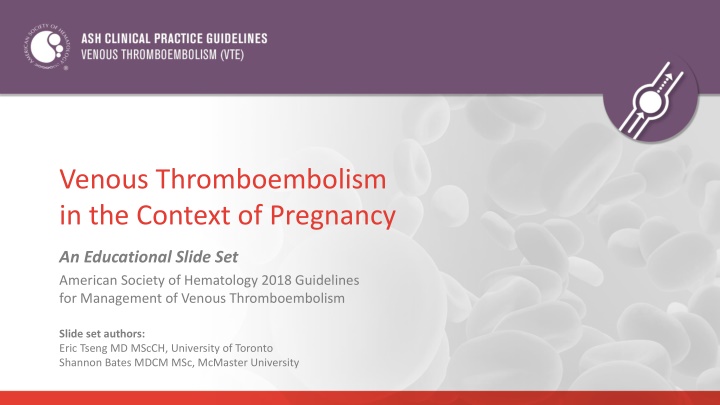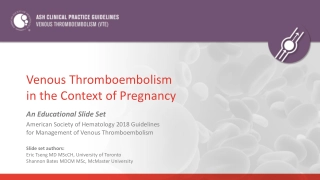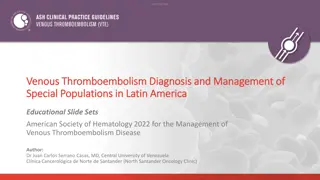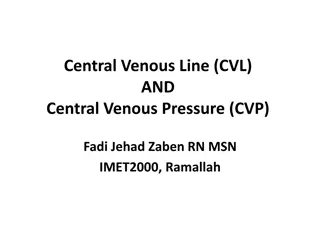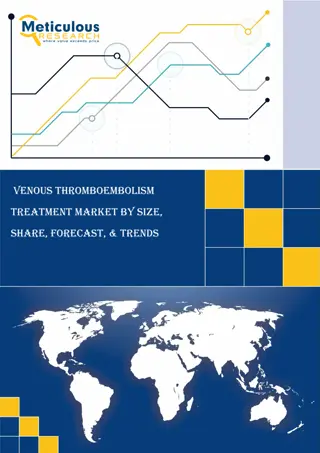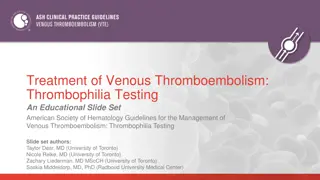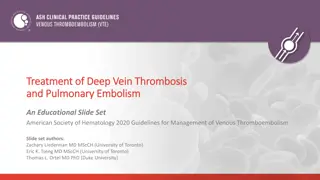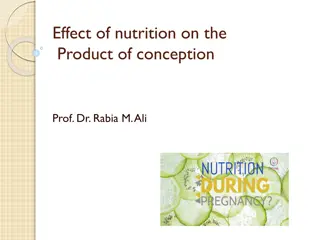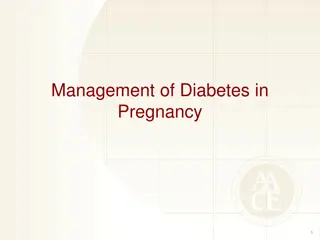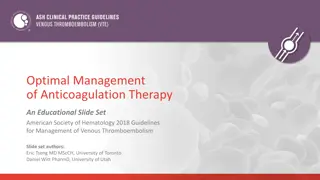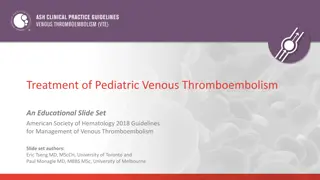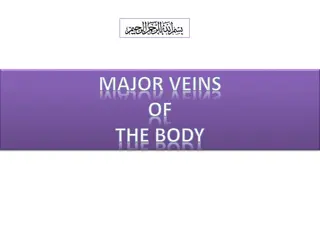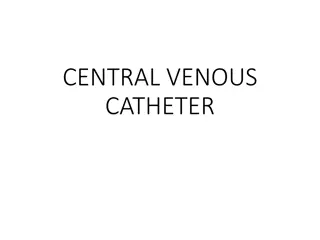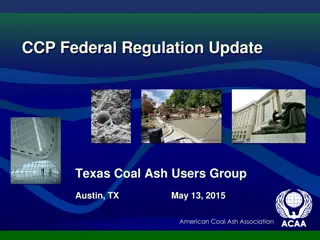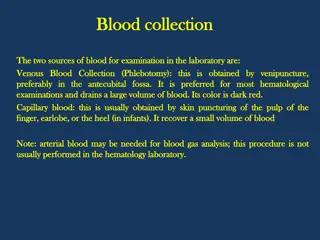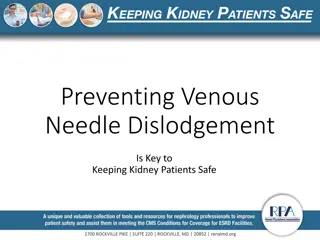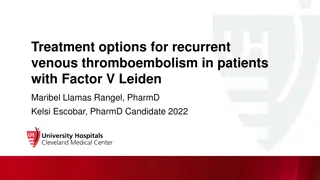ASH Guidelines on Venous Thromboembolism in Pregnancy
The American Society of Hematology (ASH) 2018 guidelines provide comprehensive management recommendations for venous thromboembolism in pregnancy. Key aspects include panel formation, clinical questions generation, evidence synthesis, and making recommendations. The guidelines offer strong and conditional recommendations based on patient preferences. Both patients and clinicians must consider these recommendations for optimal care in managing VTE during pregnancy.
Download Presentation

Please find below an Image/Link to download the presentation.
The content on the website is provided AS IS for your information and personal use only. It may not be sold, licensed, or shared on other websites without obtaining consent from the author.If you encounter any issues during the download, it is possible that the publisher has removed the file from their server.
You are allowed to download the files provided on this website for personal or commercial use, subject to the condition that they are used lawfully. All files are the property of their respective owners.
The content on the website is provided AS IS for your information and personal use only. It may not be sold, licensed, or shared on other websites without obtaining consent from the author.
E N D
Presentation Transcript
Venous Thromboembolism in the Context of Pregnancy An Educational Slide Set American Society of Hematology 2018 Guidelines for Management of Venous Thromboembolism Slide set authors: Eric Tseng MD MScCH, University of Toronto Shannon Bates MDCM MSc, McMaster University
American Society of Hematology 2018 guidelines for management of venous thromboembolism: venous thromboembolism in the context of pregnancy Shannon M. Bates, Anita Rajasekhar, Saskia Middeldorp, Claire McLintock, Marc A. Rodger, Andra H. James, Sara R. Vazquez, Ian A. Greer, John J. Riva, Meha Bhatt, Nicole Schwab, Danielle Barrett, Andrea LaHaye, and Bram Rochwerg
ASH Clinical Practice Guidelines on VTE 1. Prevention of VTE in Surgical Hospitalized Patients 2. Prevention of VTE in Medical Hospitalized Patients 3. Treatment of Acute VTE (DVT and PE) 4. Optimal Management of Anticoagulation Therapy 5. Prevention and Treatment of VTE in Patients with Cancer 6. Heparin-Induced Thrombocytopenia (HIT) 7. Thrombophilia 8. Pediatric VTE 9. VTE in the Context of Pregnancy 10. Diagnosis of VTE
How were these ASH guidelines developed? PANEL FORMATION Each guideline panel was formed following these key criteria: Balance of expertise (including disciplines beyond hematology, and patients) Close attention to minimization and management of COI CLINICAL QUESTIONS 10 to 20 clinically- relevant questions generated in PICO format (population, intervention, comparison, outcome) EVIDENCE SYNTHESIS Evidence summary generated for each PICO question via systematic review of health effects plus: Resource use Feasibility Acceptability Equity Patient values and preferences MAKING RECOMMENDATIONS Recommendations made by guideline panel members based on evidence for all factors. Example: PICO question Should postpartum prophylaxis vs. no postpartum prophylaxis be used for pregnant women with prior VTE?
How patients and clinicians should use these recommendations STRONG Recommendation ( The panel recommends ) CONDITIONAL Recommendation ( The panel suggests ) Most individuals would want the intervention. A majority would want the intervention, but many would not. For patients Different choices will be appropriate for different patients, depending on their values and preferences. Use shared decision making. Most individuals should receive the intervention. For clinicians
Objectives By the end of this session, you should be able to 1. Describe recommendations for the management of acute VTE in pregnancy 2. Describe which anticoagulants can safely be used in women who are pregnant or breastfeeding 3. Identify which pregnant patients merit antepartum and/or postpartum VTE prophylaxis
VTE is a leading cause of morbidity and mortality in pregnancy Incidence of VTE is similar in antepartum and postpartum periods, but postpartum period shorter so higher daily VTE risk Venous thrombosis complicates approximately 1.2 in 1,000 deliveries Increased risk persists until 12 weeks postpartum, with greatest risk in first 6 weeks after delivery Diagnosis, prevention, and treatment of VTE in pregnancy must consider both fetal and maternal well-being
Case 1: Suspected Deep Vein Thrombosis 32 year old female, 28 weeks gestational age. 1st pregnancy. Past Medical History: None. No prior arterial or venous thrombosis. Medications: Prenatal vitamin Seen in the Emergency Department with: New swollen and painful left thigh x 48 hours. No chest pain or dyspnea. Proximal compression ultrasound of the left lower extremity: No evidence of DVT in the popliteal, femoral, common femoral, or external iliac veins.
Your patient is 28 weeks pregnant and has unexplained left leg swelling and pain. Her left leg proximal compression ultrasound does not demonstrate proximal DVT. She has no signs or symptoms suggestive of PE. Which diagnostic test would you suggest next in her care? A. B. C. D. E. No further investigations D-Dimer test Serial compression ultrasound (US) of lower extremity Magnetic resonance venography (MR-V) Ventilation/Perfusion (V/Q) scan Either C or D
Recommendation For pregnant women with suspected DVT, the panel suggests additional investigations including serial compression ultrasound or MR-V, compared with no further investigations, following an initial negative ultrasound with imaging of the iliac veins (conditional recommendation, low certainty). Option 1: Serial US Repeating US within 7 days appears to be safe strategy with low rate of missed VTE in observational studies Option 2: MR-V May detect pelvic DVT not seen on compression US. MRI in first trimester not associated with fetal harm. Remarks: Standard compression US: limited sensitivity for pelvic/iliac DVT, which account for majority of DVT in pregnancy Single US not sufficient to rule out DVT, as up to 24% of DVT in pregnancy will be found on serial testing (very uncertain estimates)
Case 1: Continued Your patient is discharged and scheduled for a serial compression US in 5 days Examination: Blood pressure 120/84 Heart rate 86 Respiratory rate 16 Oxygen saturation 98% on room air Left leg warm, with normal pulses and sensation Her repeat US demonstrates an occlusive DVT in the left common femoral vein She is ambulatory and her pain is persistent, but controlled with acetaminophen
Your patient is 29 weeks pregnant and has an acute proximal DVT. She is ambulatory and hemodynamically stable. What anticoagulant therapy would you suggest for her DVT? (UFH = unfractionated heparin, LMWH = low molecular weight heparin) A. Subcutaneous UFH B. Direct oral anticoagulant C. LMWH once or twice daily, with anti-Xa monitoring D. LMWH once or twice daily, without anti-Xa monitoring
Which anticoagulants can safely be used during pregnancy? Acceptability in Pregnancy Anticoagulant Comments Does not cross the placenta LMWH preferred over UFH due to maternal safety profile (likely lower risk of HIT, reduced bone mineral density) LMWH Yes UFH Yes Does not cross the placenta Reported to cross placenta in small amounts Clinical experience with fondaparinux very limited Fondaparinux Not preferred Crosses the placenta Potential for teratogenicity, pregnancy loss, fetal bleeding, neurodevelopmental deficits Vitamin K Antagonist (VKA) No Direct Oral Anticoagulants Dabigatran and Xa inhibitors likely cross the placenta Reproductive effects in humans are unknown No
Recommendation For pregnant women with acute VTE treated with LMWH, the panel suggest either once-daily or twice-daily dosing regimens (conditional recommendation, very low certainty). LMWH dosed twice daily compared with once daily: Low certainty and imprecision in estimates of benefits and harms Therefore either once- or twice-daily dosing appears reasonable. Consider potential impact of dosing frequency on feasibility and acceptability. Clinical Outcome Number of Studies Impact of Dosing Regimens 2 observational studies Low overall incidence of VTE (<1%), with no difference between two dosing schedules Recurrent PE 2 observational studies Low overall incidence of VTE (<1%), with no difference between two dosing schedules Recurrent DVT Major Bleeding (antenatal or postpartum) 2 observational studies Low overall incidence of major bleeding (<1%), with no difference between two dosing schedules Quality of Evidence (GRADE): Low Moderate Strong
Recommendation For pregnant women receiving therapeutic LMWH for the treatment of VTE, the panel suggests against routine monitoring of anti-Xa levels to guide dosing (conditional recommendation, low certainty). Remarks: Only limited direct data: one small observational study (n = 26) with 11 patients receiving anti-Xa monitoring, 15 receiving no anti-Xa monitoring; no difference in recurrent VTE or bleeding Anti-Xa tests may be unreliable and not routinely available in all centres No established therapeutic range for LMWH in pregnancy Potential drawbacks of testing: frequent blood tests, clinic visits, cost In absence of evidence of benefit, the panel suggests against routine monitoring anti-Xa during treatment for VTE McDonnell BP J Thromb Thrombolysis 2017
Does this patient need to be admitted? Not necessarily. Recommendation In pregnant women with low risk acute VTE, the panel suggests initial outpatient therapy over hospital admission (conditional recommendation, low certainty). In non-pregnant patients: Outpatient treatment associated with better patient satisfaction and social functioning without negative impact on VTE outcomes. Extrapolating from non-pregnant data (and observational data in pregnancy): Outpatient therapy in pregnancy likely as beneficial as hospital-based treatment, with improved acceptability. Caution: outpatient therapy may not be appropriate for non-low-risk individuals:** Abnormal vital signs Severe analgesic needs Extensive VTE Advanced gestational age Maternal comorbidities Contraindications to LMWH Lack of home support **Outpatient therapy only appropriate if patients provided appropriate education, follow-up assured, and on-call services available. If expertise for patient training and outpatient monitoring not available, low-risk patients may benefit from initial hospitalization.
Your patient has a proximal DVT in the common femoral vein. You start her on full dose LMWH, once daily. After 3 days of outpatient treatment she is ambulatory, but continues to complain of swelling and pain in her thigh. She asks: Should we remove the clot more quickly? Will that help me feel better and improve my chances for recovery in future? Should you refer this patient for catheter-directed thrombolysis (CDT)? A. B. Yes No
Recommendation In pregnant women with acute lower-extremity deep vein thrombosis, the panel suggests against the addition of catheter-direct thrombolysis therapy to anticoagulation (conditional recommendation, low certainty) Remarks: In non-pregnant individuals, CDT does not appear to reduce the risk of post- thrombotic syndrome, except possibly those with iliofemoral DVT (ATTRACT study) Pregnancy-specific data limited to case series with low certainty of evidence, so difficult to draw substantive conclusions regarding benefit Possible harms from CDT: fetal radiation exposure, increase in major bleeding (ATTRACT study) At this juncture, CDT is probably best reserved for those with limb-threatening deep vein thrombosis Vedantham NEJM 2017
Case 1: Continued You elect against CDT, and your patient continues on full dose LMWH (dalteparin 200 IU/kg) once daily, without anti-Xa monitoring Within 2 weeks, her leg swelling and pain improve substantially She is now 35 weeks gestational age and you are evaluating her in your clinic before her delivery date
Your patient is on therapeutic dose LMWH. She is 35 weeks gestational age and her estimated delivery date is 5 weeks from today. She would prefer to have a vaginal delivery with epidural anesthesia. What do you suggest for managing her anticoagulation around the time of delivery? A. Switch anticoagulation to intravenous heparin, then scheduled (induced) delivery with discontinuation of IV heparin 6 hours before Scheduled (induced) delivery with discontinuation of LMWH 24 hours before Allow for spontaneous labour before stopping LMWH anticoagulation Scheduled cesearean section with discontinuation of LMWH 24 hours before Stop her LMWH now as she no longer requires anticoagulation B. C. D. E.
Recommendation For pregnant women receiving therapeutic-dose LMWH for VTE, the panel suggests scheduled delivery with prior discontinuation of anticoagulant therapy (conditional recommendation, very low certainty) Remarks: Observational data suggest increase in postpartum hemorrhage if therapeutic anticoagulation stopped with spontaneous onset of labor, compared with planned induction (RR 1.9, 95% CI 0.6 to 5.8) North American anesthesia guidelines specify 24-hour interval between therapeutic LMWH and placement of neuraxial anesthesia Induction of labor is not associated with maternal or fetal harm A scheduled induction may facilitate neuraxial anesthesia and reduce maternal bleeding risk (very low certainty of evidence)
Case 1: Continued She undergoes a scheduled, induced vaginal delivery at 40 weeks gestational age. Her last dose of LMWH is given 24 before her induction date, and the delivery is uncomplicated You are now assessing her in the postpartum setting. Hemostasis has been achieved, and the obstetrics team is comfortable with resumption of full dose anticoagulation Your patient plans on breastfeeding her new infant
Your patient requires 6 weeks of postpartum anticoagulation for her pregnancy-associated VTE. She plans on breastfeeding. Which ONE of the following anticoagulants is contraindicated in breastfeeding women? A. B. C. D. E. Fondaparinux LMWH Danaparoid Rivaroxaban Warfarin
Recommendations For breastfeeding women who have an indication for anticoagulation, the panel recommends using UFH, LMWH, warfarin, acenocoumarol, fondaparinux, or danaparoid as safe options (strong recommendation, low certainty) For breastfeeding women who have an indication for anticoagulation, the panel recommends against using direct-acting oral anticoagulants(strong recommendation, very low certainty) Acceptability in Breastfeeding Anticoagulant Comments UFH Yes Does not pass into breast milk due to large size and negative charge Excreted into breast milk in small amounts, but limited bioavailability so unlikely to be absorbed by newborn LMWH Yes Non-lipophilic VKAs (warfarin, acenocoumarol) unlikely to be secreted in breast milk; small studies showing no detectable levels Non-lipophilic VKA Yes Case reports suggesting low excretion of rivaroxaban into breast milk (estimated relative infant dose < 2%), but limited experience Paucity of data on all direct oral anticoagulants, including rivaroxaban Rivaroxaban No
Your patient continues full dose LMWH for an additional 6 weeks. She completes this period of postpartum anticoagulation with no complications. Three years later, she informs you that she is 10 weeks pregnant with her second child. She is concerned about developing VTE again during pregnancy. What would you recommend for prevention of VTE during this pregnancy? A. B. C. D. E. No prophylactic anticoagulation is recommended Serial bilateral leg ultrasound, and treatment only if recurrent DVT is diagnosed Antepartum anticoagulant prophylaxis only Postpartum anticoagulant prophylaxis only Antepartum and postpartum anticoagulant prophylaxis
Recommendation For women not already receiving long-term anticoagulant therapy who have a history of VTE, the panel makes the following recommendations: Antepartum Prophylaxis Postpartum Prophylaxis Prior VTE History Unprovoked VTE (strong recommendation, low certainty) Yes Yes Provoked VTE, Hormonal risk factor (strong recommendation, low certainty) Yes Yes Provoked VTE, Non-Hormonal risk factor (conditional recommendation, low certainty) No** Yes These recommendations were made based on a VTE risk threshold of 2% antepartum and 1% postpartum for recommending LMWH prophylaxis **as long as no current additional risk factors for VTE
Antepartum prophylaxis compared with no antepartum prophylaxis in pregnant women with prior VTE: In pooled estimates, in the antepartum period the risks of recurrent VTE are: Without antepartum prophylaxis: 4.2% (95% CI, 0.3% to 6.0%) With antepartum prophylaxis provided: 0.9% (95% CI, 0.5% to 1.8%) Anticipated absolute effects (95% CI) Relative effect (95% CI) Outcomes Risk with no antepartum prophylaxis Risk difference with antepartum prophylaxis 26 fewer VTE per 1,000 (12 fewer to 33 fewer) RR 0.39 (0.21 to 0.72) Recurrent VTE 27 out of 645 (4.2%) Major bleeding, antepartum 4 fewer bleeds per 1,000 (6 fewer to 14 more) RR 0.34 (0.04 to 3.21) 3 out of 473 (0.6%) Major bleeding, peripartum 5 fewer bleeds per 1,000 (19 fewer to 26 more) RR 0.82 (0.36 to 1.86) 12 out of 395 (3.0%) Quality of Evidence (GRADE): Low Moderate Strong
Postpartum prophylaxis compared with no postpartum prophylaxis in pregnant women with prior VTE: In pooled estimates, in the postpartum period the risks of recurrent VTE are: Without antepartum prophylaxis: 6.5% (95% CI, 4.3% to 9.7%) With antepartum prophylaxis provided: 1.8% (95% CI, 1.2% to 2.7%) Anticipated absolute effects (95% CI) Relative effect (95% CI) Outcomes Risk with no postpartum prophylaxis Risk difference with postpartum prophylaxis 48 fewer VTE per 1,000 (33 fewer to 55 fewer) RR 0.27 (0.15 to 0.49) Recurrent VTE 22 out of 337 (6.5%) Major bleeding, postpartum 0 fewer bleeds per 1,000 (0 fewer to 0 fewer) RR 0.71 (0.03 to 14.70) 3 out of 473 (0.6%) Major bleeding, peripartum 5 fewer bleeds per 1,000 (19 fewer to 26 more) RR 0.82 (0.36 to 1.86) 12 out of 395 (3.0%) Quality of Evidence (GRADE): Low Moderate Strong
Case 1: Conclusion After careful consideration, your patient is started on antepartum and postpartum anticoagulant prophylaxis with prophylactic LMWH The pregnancy proceeds without signs or symptoms of VTE recurrence
Case 1: Summary LMWH dosed either once or twice daily, without routine anti-Xa monitoring, is the preferred treatment for acute VTE in pregnancy Pregnant women who are receiving therapeutic LMWH for pregnancy-associated VTE should have a scheduled delivery to facilitate neuraxial anesthesia and reduce bleeding risk Women with previous unprovoked VTE or VTE provoked by hormonal risk factors should receive antepartum and postpartum anticoagulant prophylaxis
Case 2: Deciding About Prophylaxis 32 year old female, 12 weeks gestational age, 1st pregnancy Past Medical History: None. Medications: Prenatal Vitamin You are assessing her in your clinic: She has no personal history of arterial or venous thrombosis There is a positive family history for VTE Mother: postpartum PE at age 32 Mother s sister: unprovoked DVT at age 34 Both family members have been diagnosed with Antithrombin Deficiency; mother s Antithrombin activity was 0.35 U/mL (normal > 0.80 U/mL)
Your patient has no personal history of VTE. There is a significant family history of VTE, and confirmed Antithrombin Deficiency. You arrange for testing, and your patient is found to have an Antithrombin activity of 0.38 U/mL (normal > 0.80). What would you suggest for prevention of pregnancy-associated VTE during her first pregnancy? A. B. C. D. E. No prophylactic anticoagulation is recommended Serial bilateral leg ultrasound and treatment only if recurrent DVT is diagnosed Antepartum anticoagulant prophylaxis only Postpartum anticoagulant prophylaxis only Antepartum and postpartum anticoagulant prophylaxis
Recommendation For women who do not have a personal history of VTE, the panel recommends: Hereditary Thrombophilia in Patient Family History of VTE Antepartum Prophylaxis Postpartum Prophylaxis These recommendations were made based on a VTE risk threshold of 2% antepartum and 1% postpartum for recommending LMWH prophylaxis Heterozygous PGM or Heterozygous Factor V Leiden (+) No No (-) No No Our patient: Antithrombin deficiency with (+) family history. Her estimated risk of VTE is 2.7% antepartum, 4.8% postpartum which exceed risk thresholds for prophylaxis. (+) No Yes Protein S Deficiency or Protein C Deficiency (-) No No (+) Yes Yes Antithrombin Deficiency (-) No No Quality of Evidence (GRADE): Low Moderate Strong
Recommendation For women who do not have a personal history of VTE, the panel recommends: Hereditary Thrombophilia in Patient Family History of VTE Antepartum Prophylaxis Postpartum Prophylaxis No formal recommendation** (+) Yes Homozygous PGM (-) No Yes (+) Yes Yes Homozygous Factor V Leiden (-) Yes Yes (+) Yes Yes Combined thrombophilia (-) Yes Yes **No formal recommendation as no family studies available in homozygous PGM. However, panel members favor antepartum prophylaxis given VTE risk estimates Quality of Evidence (GRADE): Low Moderate Strong
Your patient requires antepartum and postpartum anticoagulant prophylaxis. What dose of prophylactic LMWH is suggested for patients requiring antepartum and postpartum prophylaxis? A. B. C. D. Antepartum: standard dose, Postpartum: standard dose Antepartum: standard dose, Postpartum: intermediate dose Antepartum: intermediate dose, Postpartum: intermediate dose Antepartum: intermediate dose, Postpartum: therapeutic dose
Recommendation For pregnant women who require prophylaxis, the panel suggests against intermediate-dose LMWH prophylaxis compared to standard-dose LMWH prophylaxis during the antepartum period (conditional recommendation, very low certainty) The panel suggests either standard- or intermediate-dose LMWH prophylaxis during the postpartum period (conditional recommendation, very low certainty) Favor standard-dose antepartum to minimize risks of bleeding or delayed epidural access Standard- or intermediate-dose reasonable for postpartum prophylaxis given increased thrombotic risk after delivery Remarks: Very low certainty evidence suggesting unclear net health benefit for using intermediate dosing However, difficult to make significant conclusions given limitations in evidence
Case 2: Continued After discussing the benefits and risks, you start your patient on antepartum and postpartum anticoagulant prophylaxis with prophylactic LMWH. She tolerates the injections, and there are no signs or symptoms of VTE. She develops no bleeding or bruising. You are now seeing her in your clinic at 35 weeks gestational age.
She is 35 weeks gestational age and will be delivering at 40 weeks, she hopes via vaginal delivery with epidural anesthesia. What would you suggest for management of her prophylactic LMWH around delivery? A. Switch anticoagulation to intravenous heparin, then scheduled (induced) delivery with discontinuation of IV heparin 6 hours before Scheduled (induced) delivery with discontinuation of LMWH 24 hours before Allow for spontaneous labor before stopping LMWH anticoagulation Scheduled cesearean section with discontinuation of LMWH 24 hours before Stop her LMWH now as she no longer requires anticoagulation for her DVT B. C. D. E.
Recommendation In pregnant women receiving prophylactic-dose LMWH, the panel suggests against scheduled delivery with discontinuation of prophylactic anticoagulation compared to allowing spontaneous labor (conditional recommendation, very low certainty) Remarks: 12-hour interval between last dose of standard prophylactic LMWH and epidural catheter would allow most women to receive neuraxial anesthesia regardless of scheduled or spontaneous delivery No clear evidence of increased bleeding risk with spontaneous delivery on prophylactic LMWH Allowing spontaneous labor may minimize the need for medical intervention in labor, and reduce the medicalization of delivery that may occur with induction of labor However, women or healthcare providers who place a high priority on access to epidural anesthesia may prefer a scheduled delivery North American anesthetic guidelines call for 12-hour interval between last prophylactic dose of LMWH and epidural catheter placement
Case 2: Conclusion She continues prophylactic LMWH, and opts for spontaneous labor instead of a scheduled (induced) delivery At 39 weeks gestational age, she presents to the hospital with regular contractions. She stops her prophylactic LMWH at that point 14 hours later she is progressing in labor and an epidural catheter is inserted. The labor is uneventful, and prophylactic LMWH is resumed postpartum when hemostasis is achieved
Case 2:Summary Pregnant women with no personal history of VTE may merit anticoagulant prophylaxis depending on their family history of VTE and whether there is underlying thrombophilia Pregnant women who are receiving prophylactic-dose LMWH do not necessarily require scheduled (induced) delivery
Case 3: Superficial Vein Thrombosis 32 year old female, 26 weeks gestational age, 1st pregnancy Past Medical History: Bilateral varicose veins Medications: Prenatal vitamin You are assessing her in your clinic: 48 hours of tender, indurated varicose veins along her right calf, popliteal fossa, and medial thigh Bilateral compression ultrasounds of the lower extremities: No evidence of proximal DVT 8 cm greater saphenous vein thrombosis (superficial vein thrombosis) extending from calf to mid- thigh
She has no evidence of DVT, but has symptomatic thrombus in her greater saphenous vein. What would you suggest for management of her superficial vein thrombosis? A. B. C. D. Warm compresses and non-steroidal anti-inflammatory medications (no anticoagulants) Fondaparinux LMWH Graduated compression stockings
Recommendation For pregnant women with proven acute superficial vein thrombosis, the panel suggests that LMWH be used over not using any anticoagulant(conditional recommendation, low certainty) Anticoagulant vs. no anticoagulant for acute superficial vein thrombosis in pregnancy (data from non-pregnant studies): Anticipated absolute effects (95% CI) No specific data in pregnancy. Relative effect (95% CI) Outcomes Risk with no anticoagulation Risk difference with anticoagulation Anticoagulants likely reduce risk of VTE from SVT. 11 fewer VTE per 1,000 (7 fewer to 13 fewer) RR 0.15 (0.04 to 0.50) Any symptomatic VTE 20 out of 1500 (1.3%) RR 0.08 (0.03 to 0.22) 31 fewer ext. per 1,000 (27 fewer to 33 fewer) Fondaparinux crosses the placenta, so LMWH preferred. Extension to SFJ 51 out of 1500 (0.6%) RR 0.99 (0.06 to 15.90) 0 fewer bleeds per 1,000 (1 fewer to 10 more) Major bleeding 1 out of 1488 (0.1%) Quality of Evidence (GRADE): Low Moderate Strong
Case 3: Conclusion and Summary She starts LMWH at a prophylactic dose and continues this anticoagulant throughout the remainder of her pregnancy Within 1 week her symptoms substantially improve and there are no symptoms of proximal extension or PE She continues the prophylactic LMWH until 6 weeks postpartum It is likely that anticoagulants reduce the risk of VTE after SVT, with LMWH preferred for treatment of SVT in pregnancy.
Other guideline recommendations that were not covered in this session For these topics, conditional recommendations were made based on weak or very weak quality of evidence Anticoagulant prophylaxis for assisted reproductive technologies Anticoagulant prophylaxis for ovarian hyperstimulation syndrome Role of systemic thrombolysis for acute PE in pregnancy Diagnosis of suspected pulmonary embolism in pregnancy
Future Priorities for Research Safety of fondaparinux and direct oral anticoagulants in pregnancy Evidence regarding once versus twice daily dosing of LMWH Data regarding efficacy of catheter-directed thrombolysis, including estimated fetal radiation exposure Safety of direct oral anticoagulants in breastfeeding women Data regarding intensity of LMWH prophylaxis Data regarding impact of thrombophilia on antepartum VTE risk Validation of clinical prediction rules for diagnosis of VTE
In Summary: Back to our Objectives 1. Describe recommendations for the management of acute VTE in pregnancy LMWH, once or twice daily, without routine anti-Xa monitoring 2. Describe which anticoagulants can safely be used in women who are pregnant or breastfeeding Pregnancy: LMWH or UFH; Breastfeeding: LMWH, UFH, warfarin, acenocoumarol, fondaparinux, danaparoid 3. Identify which pregnant patients merit antepartum and/or postpartum VTE prophylaxis All patients with prior VTE merit postpartum prophylaxis Prior unprovoked and hormonal provoked VTE merit antepartum prophylaxis For women with thrombophilias, recommendations vary according to thrombophilia and family history
Acknowledgements ASH Guideline Panel team members Knowledge Synthesis team members McMaster University GRADE Centre Author of ASH VTE Slide Sets: Eric Tseng MD MScCH, University of Toronto and Shannon Bates MDCM MSc, McMaster University See more about the ASH VTE guidelines at http://www.hematology.org/VTEguidelines
